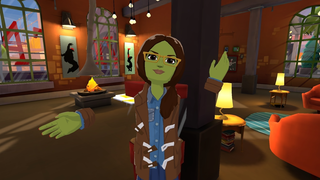I’ll state the obvious. Unless we are in “The Matrix” or characters in “Horton Hears a Who,” there is no more “meta” a universe than the one we are in. Of course, real life isn’t the metaverse that everyone is talking about. Or is it? Last I checked, no one really knows.
What’s clear is that we are experiencing a technology trend of digital and physical convergence that will shape our future. Physical-digital convergence can be as simple as a Snapchat filter, which my kids demonstrated for me because I don’t use Snapchat. Or a Pokemon Go game on your phone looking for virtual objects in real locations. Or it can mean putting on a VR headset and meeting up in a virtual world as many of us have been doing for a long time. My Avatar in AltspaceVR is part “Indiana Jones,” part “Star Trek,” and part “She-Hulk.”

My AltspaceVR Avatar
Source: Cori Lathan/AltspaceVR
So is immersive VR the metaverse? Matthew Ball, the author of The Metaverse, says that VR is only one way to experience the metaverse. He uses the analogy that smartphones are one way to experience the internet. And as I’ve already said, I believe that real life is the metaverse. The line between the digital and physical worlds moves seamlessly as we use different interfaces throughout our day. Soon, maybe I’ll walk to work with my augmented reality glasses on, which will give me my daily news and agenda for the day, and warn me of oncoming traffic if needed. Then I might work in a mixed-reality environment with my colleagues on a collaborative design project and then finally, that evening I’ll immerse myself in VR to join some friends across the country for a game night as a hologram in their real world.
The point is that I will use the appropriate technology throughout the day to make my life better. As a techno-optimist, I believe technology should make us better than we are without it. This is the theme of my new book with the same title as this blog, Inventing the Future, Stories from a Techno-Optimist.
Other technology trends will play into the emergence of the metaverse such as the internet of things. When we hear about the internet of things, we tend to hear about connected devices in our homes talking to each other and the cloud. But it is also an internet of things and people. An excerpt from my book reflects a metaverse powered by the internet of things:
Imagine you have moved to a new city and bought a condo advertised as “metaverse enabled.” You move into your neighborhood both physically and digitally. With a crypto key, you link your personal metaverse profile to the condo metaverse merging the two. As you move from your bedroom to the kitchen, the lights switch on, and the room temperature adjusts. In the kitchen, a graphical display appears in front of you as you turn your gaze toward the refrigerator. You reach out your hand and select the egg icon, which reveals that you have three eggs left. You swipe up with your hand and the order goes out for more eggs. As you prepare breakfast, you gesture again, and in another moment your mother’s face appears in front of you. “Mom, do you want to join me for breakfast?” “Sure,” she responds as she turns down your stove so your eggs don’t burn! You gather your eggs and bacon and sit down at the table, which has moved out from a recess in the wall in anticipation of your approach. You sit down, your mother’s hologram appears across from you with her breakfast, and the two of you begin to discuss your day.
We don’t really know the potential of the metaverse, but as we leverage the ever-evolving internet, advances in virtual and augmented reality technologies, and the thirst that people have to connect in innovative ways, there will likely be multiple metaverses, including a “medi-verse” that focuses on wellness and prevention as well as health care delivery. More on that in future posts.
My philosophy as an engineer and inventor is that technology should help make us stronger and healthier, technology should bridge the gap between what we can do and what we could do, and technology should create an equitable future.
Let’s build our future metaverse to do that.
Read More: news.google.com









 Bitcoin
Bitcoin  Ethereum
Ethereum  Tether
Tether  XRP
XRP  Solana
Solana  Dogecoin
Dogecoin  Cardano
Cardano  USDC
USDC  Lido Staked Ether
Lido Staked Ether  Shiba Inu
Shiba Inu  Avalanche
Avalanche  TRON
TRON  Toncoin
Toncoin  Stellar
Stellar  Wrapped stETH
Wrapped stETH  Polkadot
Polkadot  Wrapped Bitcoin
Wrapped Bitcoin  Chainlink
Chainlink  WETH
WETH  Bitcoin Cash
Bitcoin Cash  Sui
Sui  Pepe
Pepe  Litecoin
Litecoin  NEAR Protocol
NEAR Protocol  Hedera
Hedera  LEO Token
LEO Token  Uniswap
Uniswap  Aptos
Aptos  Wrapped eETH
Wrapped eETH  Internet Computer
Internet Computer  USDS
USDS  Cronos
Cronos  Ethereum Classic
Ethereum Classic  POL (ex-MATIC)
POL (ex-MATIC)  Artificial Superintelligence Alliance
Artificial Superintelligence Alliance  Bittensor
Bittensor  Render
Render  Ethena USDe
Ethena USDe  Filecoin
Filecoin  Algorand
Algorand  Arbitrum
Arbitrum  Stacks
Stacks  Dai
Dai  Celestia
Celestia  Bonk
Bonk  Cosmos Hub
Cosmos Hub  Immutable
Immutable